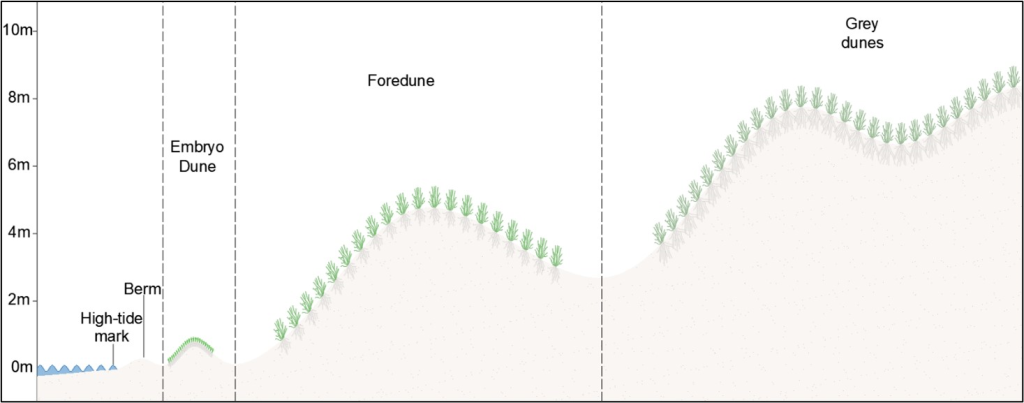Dunes & Plants
Coastal dunes, seemingly simple formations of sand shaped by wind and wave, play a vital yet often underestimated role in safeguarding our shorelines. As described in our first post in the Dune Series, these dynamic landscapes act as natural barriers, dissipating the energy of powerful waves and storm surges, thus protecting inland areas from erosion and flooding.
Crucially, the presence and health of vegetation on these dunes are inextricably linked to their protective capacity. Specialized plant communities not only stabilise the shifting sands, preventing erosion of the dune itself, but also enhance its ability to absorb wave impact and trap further sediment, fostering a resilient and self-sustaining coastal defense system.
The dune formation process is fascinating and highlights the importance and foundational role of dune vegetation. As the tides within a coastal system retreat, beach sand is exposed and dries out, allowing winds from the sea to move material up the beach. Sand becomes trapped and starts to accumulate, usually at the high springtide mark, by seaweed or driftwood – leading to the formation of small mounds known as embryo dunes. Plant species, such as marram grass, lyme grass and sand couch, start to colonise the area – stabilising and encouraging further accumulation of sand.
As more sand builds up, the embryo dunes merge to create foredunes, typically populated by marram grass and xerophytes, reaching heights of up to 5m. Over time, these foredunes evolve into grey dunes as humus and bacteria from plants and animals enrich the sand. This leads to increased vegetation, with typical plant species including creeping fescue, sea spurge, marram grass, cotton grass, and heather. These mature grey dunes can grow to heights of 10-30m before the sand supply diminishes due to their distance from the beach.

Credit: Albert
Coastal dune systems are relatively arid and, as such, require plants that are specially adapted to the harsh conditions of the environment. These adaptations include: 1) succulent leaves, leaf wax, thick cuticles, hairy leaves, leave rolling, deep roots that reach to the water table and glands that exude salt to withstand high salinity and salt spray; 2) increased development of roots, rhizomes, stolons and shoots, rapid recolonization through efficient dispersal of seeds by wind and currents, and delayed germination of seeds until conditions are favourable (dormancy) to withstand sand burial and flooding. These highly specialised plant species, often referred to as pioneer species, are vital for forming and stabilising dunes.
While highly specialised to survive in the hostile coastal environment, these dune plant species are especially sensitive to the human “effect”. For example, trampling can cause them to die back rapidly, leaving the sand exposed and vulnerable to wind and wave erosion. In such cases, what may appear to be coastal erosion driven dune retreat is actually caused by human activity.
Dune vegetation serves to stabilise dunes in two primary ways. The frictional effect of stems and foliage decreases wave runup on the dunes while the deep, extensive root systems of these species anchor the sand within the dune system and minimise sand loss to wind or wave action. The roots also improve the soil structure by adding organic material and moisture, and by strengthening the sand aggregation function of microorganisms and fungi. Additionally, the foliage of dune vegetation intercept wind-blown sand particles, increasing sand accumulation rates on the dunes – a process often replicated by the installation of sand fences, which serves both to increase interception of wind-blown sand and also to decrease foot-traffic in the vegetated areas.
Given the importance of dune systems in protecting against the erosive forces of the ocean, it is vital that measures be taken to preserve and reinforce them. The intricate partnership between coastal dunes and their vegetation is fundamental to both the existence and the resilience of these vital landforms. Vegetation acts as the very foundation for dune development and stability – recognizing and prioritizing the health and restoration of dune vegetation is therefore not merely an ecological concern, but a crucial investment in natural coastal protection, ensuring the long-term preservation of our shorelines against the increasing threats of erosion and sea-level rise.
Methods for engineered dune stabilisation and reinforcement will be discussed in upcoming posts. This is the second post in our Dune Systems Series.
Our posts are mailed to our distribution list (click to join) and posted on LinkedIn. We invite you to follow us on LinkedIn.
Albert
April 18th, 2025
© 2025 All Rights Reserved
